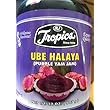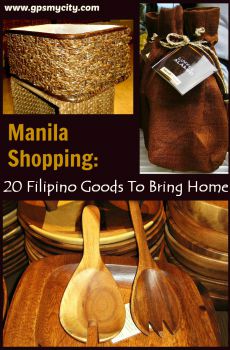
Manila Shopping: 20 Filipino Goods To Bring Home
An archipelago of 7,000+ islands, The Philippines is a diverse nation populated by different tribes, each having their own culture and traditions. In Manila, one can find a whole lot of things worth keeping as a Filipino memento; it just might take one a little while to figure out what's best and where to get it. To ease the task, we've come up with 20 souvenir ideas to address the needs of a first time visitor to the country.
(To visit the venues mentioned in this article, check out these Self-Guided Walking Tours in Manila)
1. Capiz Items
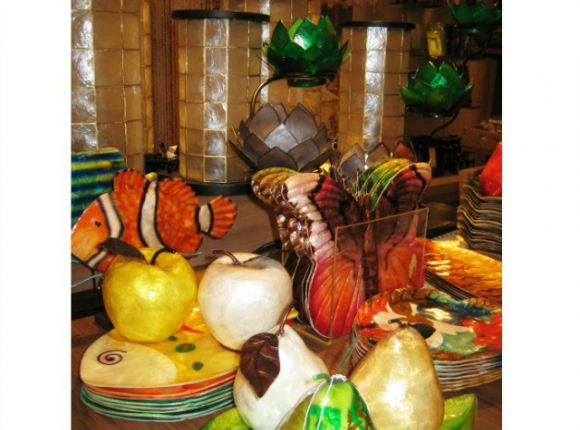
Capiz is both a geographical location and the name of a shell that is used largely in interior decorating and for decorative gifts and accessories found in the Philippines. Geographically speaking, Capiz is a province of the Philippines facing the Sibuyan Sea to the north. Capiz shell, which is used for decorative purposes, is the outer shell of the marine mollusk, Placuna placenta, found in the shallow coastal waters of the Philippines.
Capiz shells are often flat, semi-transparent with a pearlescent appearance. It is often used to create lampshades or other luminescent objects, such as candle holders, because of its striking appearance when light shines through. However, it is just as common to see the bases of lamps crafted with capiz shell. Capiz is also frequently used as an accent to many household and fashion accessories and is generally considered to be elegant and formal. The decorative purposes of capiz are virtually limitless, and the look it gives depends largely on the quantity used and the accompanying materials, with silver or gold being the most formal and wood being a more casual material combined with capiz.
The price range of the Capiz shell products is from Php 119.75 to Php 1999.75. It is available for purchase at Kultura Filipino at the 2nd floor SM Ayala, Makati City.
Capiz shells are often flat, semi-transparent with a pearlescent appearance. It is often used to create lampshades or other luminescent objects, such as candle holders, because of its striking appearance when light shines through. However, it is just as common to see the bases of lamps crafted with capiz shell. Capiz is also frequently used as an accent to many household and fashion accessories and is generally considered to be elegant and formal. The decorative purposes of capiz are virtually limitless, and the look it gives depends largely on the quantity used and the accompanying materials, with silver or gold being the most formal and wood being a more casual material combined with capiz.
The price range of the Capiz shell products is from Php 119.75 to Php 1999.75. It is available for purchase at Kultura Filipino at the 2nd floor SM Ayala, Makati City.
Where to find it:
Kultura FilipinoAddress: 1223 Palm Dr, Makati, inside SM Makati
Metro Manila, Philippines
Operation Hours: Monday-Sunday: 10AM–9PM
Jonats Handicrafts
Address: Stall 32-34 Building 11, Ortigas Ave. cor E. Rodriquez Ave. (C-5), Tiendesitas, Pasig City
Buy It on Amazon:
Offline reading and travel directions:
With GPSmyCity App you can read this article offline on your mobile device, use the embedded offline city map and GPS navigation, as well as create a self-guided walk to visit the venues featured in the article.
2. Caviar Dish

What better place to put caviar than in a exotic sea shell? And, this exotic sea shell is the mother of pearl sea shell or also called nacre. It is a s an iridescent layer of material which forms the shell lining of many mollusks. Pearl oysters and abalone are both sources of mother of pearl, which is widely used as an inlay in jewelry, furniture, and musical instruments. Mother of pearl comes in several natural colors, and is often bleached and dyed for decorative use. The dye retains the shimmering layers which make mother of pearl so sought after.
Truth be told, Mother of pearl is essential for serving caviar because it does not affect the caviar's fragile flavor. Any other type of tableware would alter the taste of caviar and distract from its natural flavor. The price range of the caviar dishes is from Php 899.00 to Php 3599.75. It is available for purchase at Kultura Filipino at the 2nd floor SM Ayala, Makati City.
Truth be told, Mother of pearl is essential for serving caviar because it does not affect the caviar's fragile flavor. Any other type of tableware would alter the taste of caviar and distract from its natural flavor. The price range of the caviar dishes is from Php 899.00 to Php 3599.75. It is available for purchase at Kultura Filipino at the 2nd floor SM Ayala, Makati City.
Where to find it:
Kultura FilipinoAddress: 1223 Palm Dr, Makati, inside SM Makati
Operation Hours: Monday-Sunday: 10AM–9PM
Offline reading and travel directions:
With GPSmyCity App you can read this article offline on your mobile device, use the embedded offline city map and GPS navigation, as well as create a self-guided walk to visit the venues featured in the article.
3. Custaroons

What do you get when you combine the classic French macaroon and a creamy leche flan? You get custaroons! A custaroon is a deliciously unique combination of smooth and creamy flan topped with a chewy, buttery crust. These bite-sized goodies were created by Gigi Gaerlan, a Filipina mom who has a passion for baking. According to Gigi, her custaroons where a product of serendipity. She was trying to bake something else and made a mistake in process and the custaroons was born. Each and every finger-licking, lip-smacking, reach-for-another goodness custaroon that comes out of the kitchen is freshly-baked.
So what do you expect for each custaroon? Expect a unique, great tasting dessert that could be eaten alone or with a beverage of their choice - they go very well with coffee and tea. The custaroons appeal to all kinds of tastes; even those who don't like macaroons enjoy my custaroons. Travelers should expect a Filipino tasting dessert that also appeals to the international market. You can purchase these yummy treats at the Custaroonery parking lot of the St. Pio Chapel Compound. The price of custaroons ranges from Php 180.00 (for a box of six) to Php 900.00 (for a box of 120 pcs).
So what do you expect for each custaroon? Expect a unique, great tasting dessert that could be eaten alone or with a beverage of their choice - they go very well with coffee and tea. The custaroons appeal to all kinds of tastes; even those who don't like macaroons enjoy my custaroons. Travelers should expect a Filipino tasting dessert that also appeals to the international market. You can purchase these yummy treats at the Custaroonery parking lot of the St. Pio Chapel Compound. The price of custaroons ranges from Php 180.00 (for a box of six) to Php 900.00 (for a box of 120 pcs).
Where to find it:
Custaroonery parking lot of the St. Pio Chapel CompoundAddress: 188 E. Rodriguez Jr. Ave. Bagumbayan, Quezon City
Website: www.custaroons.com
Opening hours: Monday-Friday: 8am-8pm;
Saturday, Sunday: 8am-9pm
Offline reading and travel directions:
With GPSmyCity App you can read this article offline on your mobile device, use the embedded offline city map and GPS navigation, as well as create a self-guided walk to visit the venues featured in the article.
4. Philippine Pearls

It is said that the pearl is the queen of gems and the gem of queens. We all know that the pearl is the oldest valued gem, but unlike other gems, it is derived from living organisms, such as mollusks - the oyster. This hard and ideally round and smooth object is naturally produced and is cultivated or harvested. Pearls come in varied colors. In the Philippines you can take fancy in the various colored pearls, such as cream-roses, cream-whites, and assorted yellows and golds.
There are cultured pearls and natural pearls. Just a bit of trivia when buying pearls. To know if the pearls that you are buying are real, attempt to scratch or bite the pearl. If the pearl leaves a mark, has a sandy feel and the mark disappears after wiping it, then the pearl is real. The most comprehensive location to purchase cultured or natural pearls is the Greenhills Shopping Center in San Juan City. The price range of pearls is from Php500.00 to Php1,000.00.
There are cultured pearls and natural pearls. Just a bit of trivia when buying pearls. To know if the pearls that you are buying are real, attempt to scratch or bite the pearl. If the pearl leaves a mark, has a sandy feel and the mark disappears after wiping it, then the pearl is real. The most comprehensive location to purchase cultured or natural pearls is the Greenhills Shopping Center in San Juan City. The price range of pearls is from Php500.00 to Php1,000.00.
Where to find it:
Greenhills Shopping CenterAddress: Ortigas Ave, San Juan City
Operation Hours: Monday-Friday: 11AM–10PM;
Saturday, Sunday: 10AM-10PM
5. Shell-Made Napkin Ring Set

We all know that setting a table to establish a mood and set a festive tone is one of the first lessons of successful entertaining. Everything on the table, from the plates to the centerpiece to the table linens and napkin rings, can support your theme. A beach theme using treasures from the sea is creative and personal, and crafting napkin rings from collected shells is a sure bet for creating that seashore feel. In addition, shell-made napkin ring sets are very impressive and expensive looking pieces for table settings. Often found in classy restaurants, these handicrafts are now accessible to those foreign travelers who are looking into impressing their guests at home. These rings sets come in various varieties of seashells. Each shell is carefully polished to create that glossy shine.
You can purchase these shell crafts napkin ring sets at Kultura Filipino. Kultura Filipino is the largest Filipino retail chain that offers authentic Philippine crafts. Alternatively, it is also available at the Jonats Crafts in Tiendesitas, Pasig City. The price of these shell-made napkin ring sets is Php 999.75 for a set of 4 pieces.
You can purchase these shell crafts napkin ring sets at Kultura Filipino. Kultura Filipino is the largest Filipino retail chain that offers authentic Philippine crafts. Alternatively, it is also available at the Jonats Crafts in Tiendesitas, Pasig City. The price of these shell-made napkin ring sets is Php 999.75 for a set of 4 pieces.
Where to find it:
Kultura FilipinoAddress: 2nd floor SM Ayala, Makati City
Operation Hours: Monday-Sunday: 10AM–9PM
6. Bamboo Baul

We all know that bamboos are actually the largest members of the grass family. It is also known as the quickest growing plant in the world. In the Philippines, it holds a notable economic and cultural significance as it's cheap and often used as building material and food source. The Philippines exposure to bamboo products comes from its trade relations with China which extends back to the 1500s. Filipinos began using bamboo as an alternative construction material.
The word baul is a Spanish word referring to a chest or trunk. The Philippines has been a colony of Spain since the 1500s, hence the similarity in the language. The Bamboo Baul is actually a decorative chest, a local version of a treasure chest made out of bamboo shoots. Bamboo bauls come in various sizes. You can actually purchase this unique piece of furniture at Kultura Filipino at the 2nd floor SM Ayala, Makati City. The shop is open from 10AM to 9PM daily. The price of the smallest bamboo baul is Php 179.75.
The word baul is a Spanish word referring to a chest or trunk. The Philippines has been a colony of Spain since the 1500s, hence the similarity in the language. The Bamboo Baul is actually a decorative chest, a local version of a treasure chest made out of bamboo shoots. Bamboo bauls come in various sizes. You can actually purchase this unique piece of furniture at Kultura Filipino at the 2nd floor SM Ayala, Makati City. The shop is open from 10AM to 9PM daily. The price of the smallest bamboo baul is Php 179.75.
Where to find it:
Kultura FilipinoAddress: 2nd floor SM Ayala, Makati City
Operation Hours: Monday-Sunday: 10AM–9PM
7. Abaca Basket

Abaca is a species of banana which is grown as a commercial crop in the Philippines. Once its fibre is harvested, it is called Manila hemp. The fibers are usually used for making twines and ropes. Abaca ropes are very durable, flexible and resistant to salt water damage.
Reflecting history and tradition, the abaca basket takes a craft indigenous to the tribes in the Philippines and gives it a clean, sophisticated shape. The dark woven basket's textured multi-colored weave takes the ancient basket shape and reinvents it with a modern twist. Abaca baskets come in several forms and sizes. One practical application of this reliable weave is traditional container to be taken along whenever you go to public markets. The price range of the Abaca baskets is from Php 100.00 to Php 499.75. It is available for purchase at Kultura Filipino at the 2nd floor SM Ayala, Makati City. The shop is open from 10AM to 9PM daily.
Reflecting history and tradition, the abaca basket takes a craft indigenous to the tribes in the Philippines and gives it a clean, sophisticated shape. The dark woven basket's textured multi-colored weave takes the ancient basket shape and reinvents it with a modern twist. Abaca baskets come in several forms and sizes. One practical application of this reliable weave is traditional container to be taken along whenever you go to public markets. The price range of the Abaca baskets is from Php 100.00 to Php 499.75. It is available for purchase at Kultura Filipino at the 2nd floor SM Ayala, Makati City. The shop is open from 10AM to 9PM daily.
8. Kamagong Salad Server

Most times we look for ways to have our dinner look nice in presentation. This can be achieved with a beautiful salad bowl and server. The server makes it easier to serve your family and dinner guests their salad and it looks nicer than a regular spoon or fork. There are many different types of salad servers that you can purchase. One of them is wood. Wooden salad servers look beautiful with a nice wooden bowl to present your salad in. When our presentation on salads may be lacking, adding a nice wooden bowl and server can turn it into a more eye-pleasing presentation.
In the Philippines, Kamagong timber is extremely dense and very famous for its dark colors. Like many hard woods, it has iron-like hardness and is nearly unbreakable, hence the term “ironwood”. A true Filipino ingenuity is harvesting the Kamagong tree and converting its branches into kitchen utensils, such as salad servers. Anyone who has ever owned wood salad servers can tell you, there is just something better and tastier about mixing and serving salads with it. Whether it is the slight absorption of the oils in the dressing or the gentle way the bowl treats the salad leaves, there is a distinctly wonderful flavor to salads mixed in a wooden salad bowl with wooden servers. The price range of the Kamagong salad servers is from Php 100.00 to Php 499.75. It is available for purchase at Kultura at SM Mall Makati City. The shop is open from 10AM to 9PM daily.
In the Philippines, Kamagong timber is extremely dense and very famous for its dark colors. Like many hard woods, it has iron-like hardness and is nearly unbreakable, hence the term “ironwood”. A true Filipino ingenuity is harvesting the Kamagong tree and converting its branches into kitchen utensils, such as salad servers. Anyone who has ever owned wood salad servers can tell you, there is just something better and tastier about mixing and serving salads with it. Whether it is the slight absorption of the oils in the dressing or the gentle way the bowl treats the salad leaves, there is a distinctly wonderful flavor to salads mixed in a wooden salad bowl with wooden servers. The price range of the Kamagong salad servers is from Php 100.00 to Php 499.75. It is available for purchase at Kultura at SM Mall Makati City. The shop is open from 10AM to 9PM daily.
Where to find it:
Kultura FilipinoAddress: 2nd floor SM Ayala, Makati City
Operation Hours: Monday-Sunday: 10AM–9PM
9. Salakot Ashtray
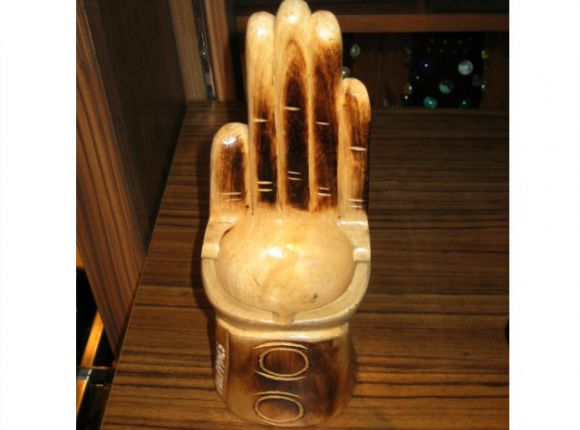
A salakot is a traditional wide-brimmed hat worn in the Philippines. It is usually made of either rattan or reeds, and is one of the most popular kinds of headwear with the Filipinos, other than the iconic conical Asian hat. Some Filipino artist were inspired to create decorative pieces from it, e.g. ashtrays. An ashtray is a decorative solution to keep it clean in the household. Since wood is a commonly found raw material in the Philippines, it's no surprise that Filipino would eventually create intricate ashtray carvings from these woods.
Another reason is, traditionally, that Filipino men love to smoke as many of the indigenous tribes of the Philippine northern provinces produce tobacco as a means of trade. In fact, all these wooden ashtrays are made and handcrafted by the indigenous tribes from the Cordillera Region – the Igorots, specifically from the City of Baguio. Wooden ashtrays are not always depicted in traditional Filipino hats. There are many kinds of wooden ashtrays. For example, the quadruple head ashtray, the cobra ashtray, the human head ashtray, the coffee mug ashtray and the most humorous of them all - the Phallic ashtray. This ashtray is the most unique of them all. You can choose from small, medium, large and extra large sizes available. Phallus is used in many religions, especially here in the Orient, as a symbol of the degenerative power of nature.
These ashtrays can be a perfect gift for smoker friends and relatives, as well as for non-smokers as collector’s items or home decor. The price range of these wooden ashtrays is from about Php 100 to Php 250.00. It is available for purchase at Jonats Handicrafts at Stall 32-34 Building 11, Tiendesitas, Pasig City. You can ask Ms. Nora or Ms. Linda. The shop is open from 10AM to 7PM daily.
Another reason is, traditionally, that Filipino men love to smoke as many of the indigenous tribes of the Philippine northern provinces produce tobacco as a means of trade. In fact, all these wooden ashtrays are made and handcrafted by the indigenous tribes from the Cordillera Region – the Igorots, specifically from the City of Baguio. Wooden ashtrays are not always depicted in traditional Filipino hats. There are many kinds of wooden ashtrays. For example, the quadruple head ashtray, the cobra ashtray, the human head ashtray, the coffee mug ashtray and the most humorous of them all - the Phallic ashtray. This ashtray is the most unique of them all. You can choose from small, medium, large and extra large sizes available. Phallus is used in many religions, especially here in the Orient, as a symbol of the degenerative power of nature.
These ashtrays can be a perfect gift for smoker friends and relatives, as well as for non-smokers as collector’s items or home decor. The price range of these wooden ashtrays is from about Php 100 to Php 250.00. It is available for purchase at Jonats Handicrafts at Stall 32-34 Building 11, Tiendesitas, Pasig City. You can ask Ms. Nora or Ms. Linda. The shop is open from 10AM to 7PM daily.
Where to find it:
Jonats HandicraftsAddress: Stall 32-34 Building 11, Ortigas Ave. cor E. Rodriquez Ave. (C-5), Tiendesitas, Pasig City
Operation Hours: Monday-Sunday: 10AM–7PM
10. Abaca Placemats, Napkins and Coasters
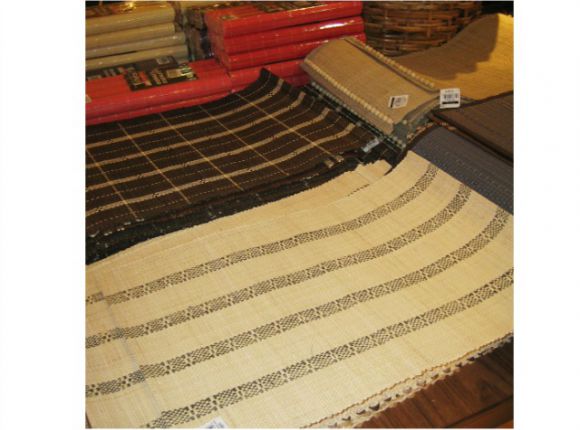
Similar to the abaca baskets, manila hemp can be made into colorful and organic table sets, such as placemats, coasters and napkins. Traditionally, these can be found in ancestral homes in the outskirts of Manila. Back when the whole world was lobbying for environmentally safe products, Filipinos have already invented environmentally sound kitchen items. These placemats, coasters and napkins are sturdy and durable organic table settings that are both environment friendly and elegantly decorative. These dinner setting companions will surely make your dining experience more homey and create an organic feel. Many of the dinner setting companions can be found in Kultura Filipino at the 2nd Floor of SM Ayala, Makati City. The price of these decorative beauties ranges from Php 99.75 to Php 399.75.
11. Banig
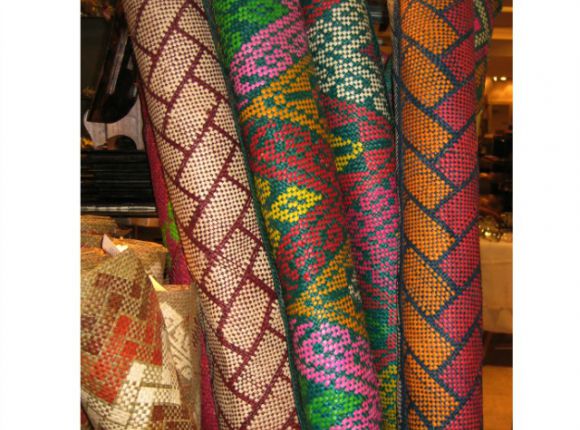
If yoga mats are for meditation, a banig is for sleeping. Banig refers to the woven mats traditionally made in the Philippines and used mostly for sleeping or sitting on. The designs and motifs of banig, as well as the raw materials used in weaving, vary from on ethnic tribe to another. Depending on the region, banig or mats can be made either from the palm, pandan, buri, tikog or reed (sea grass leaves), which are the native plants for different parts of the Philippines. Mats coming from the south are characterized by vibrant color and spontaneous geometric patterns and symbols reflecting marine life. Banig from the north have solid and darker hue because of the kind of raw materials they use.
Today, where once the age-old mat was used solely for sleeping, it now adorns modern walls or ceiling panels. Bbanig has been turned into bags, throw pillows, framed decors, as well as place mats and furniture matting. Various styles and designs of banig can be found in Kultura Filipino at the 2nd Floor of SM Ayala, Makati City. The price ranges from Php 1,499.75 to Php 1,500.
Today, where once the age-old mat was used solely for sleeping, it now adorns modern walls or ceiling panels. Bbanig has been turned into bags, throw pillows, framed decors, as well as place mats and furniture matting. Various styles and designs of banig can be found in Kultura Filipino at the 2nd Floor of SM Ayala, Makati City. The price ranges from Php 1,499.75 to Php 1,500.
Where to find it:
Kultura FilipinoAddress: 2nd floor SM Ayala, Makati City
Operation Hours: Monday-Sunday: 10AM–9PM
12. Philippine Jeepney Artworks

A jeepney is the most popular means of transportation in the Philippines. Everywhere in the pages of travel brochures, the jeepney is often blazoned as an "essential part of the Philippine adventure". The jeepney has come a long way from being the World War 2 Willys jeep surplus that provided an early postwar topless form of share-taxi transportation in the Philippines. Even as the supply became scarce, the jeepneys continued to spawn an industry and commerce of build-from-scratch jeepney production, providing the needs of the population for an affordable means of transportation and all imaginable hauling needs. It was, indeed, the workhorse of Philippine transportation, and deservedly, for decades, it was the "Undisputed King of the Road."
Still, no two jeepneys are alike. This is because a jeepney is a canvas for art. Jeepney art is a combination of the "art of the accessory" and the "art of the color" applied on a basic canvas shell of galvanized metal or buffed and glimmering stainless steel. Anachronistic, unchanging, dreadfully unaerodynamic, punishingly uncomfortable — Yes, the jeepney is all that. But, more than a riveted and welded box on wheels, it is also a vehicle of the Filipino ethos and zaniness, an essential ingredient of the Filipino archetype. To ride one, is sure way to take a peek at the Filipino mentality.
To remind yourself of that Philippine adventure, you can bring home decorative models by visiting Kultura Filipino at the 2nd Floor of SM Ayala, Makati City. The price range for these decorative beauties is from Php 300.00 to Php 500.00. Alternatively, you can also purchase them at Jonats Handicrafts in Stall 32-34 Building 11, Tiendesitas, Pasig City.
Still, no two jeepneys are alike. This is because a jeepney is a canvas for art. Jeepney art is a combination of the "art of the accessory" and the "art of the color" applied on a basic canvas shell of galvanized metal or buffed and glimmering stainless steel. Anachronistic, unchanging, dreadfully unaerodynamic, punishingly uncomfortable — Yes, the jeepney is all that. But, more than a riveted and welded box on wheels, it is also a vehicle of the Filipino ethos and zaniness, an essential ingredient of the Filipino archetype. To ride one, is sure way to take a peek at the Filipino mentality.
To remind yourself of that Philippine adventure, you can bring home decorative models by visiting Kultura Filipino at the 2nd Floor of SM Ayala, Makati City. The price range for these decorative beauties is from Php 300.00 to Php 500.00. Alternatively, you can also purchase them at Jonats Handicrafts in Stall 32-34 Building 11, Tiendesitas, Pasig City.
13. Coconut Wine
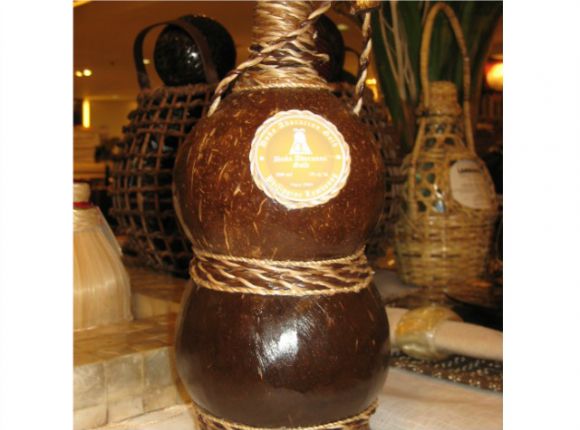
Lambanog is a Philippine alcoholic beverage, most commonly described as coconut wine or coconut vodka. The drink is distilled from the sap of the unopened coconut flower, and is known for its potency and high alcohol content (80 and 90 proof). Most of the lambanog distilleries are in the Quezon province of Luzon, Philippines. Because coconut trees abound throughout the Philippines, and because the process of distilling lambanog from tuba is a relatively inexpensive process, it is known as a poor man’s drink. Farmers often wind down by drinking lambanog after a long day’s work. Drinking lambanog is usually a communal thing – men sit around in a circle and take turns drinking shots from a cup placed in the middle of the group. Usually, there is also someone singing and playing the guitar to add to the festivities; he takes his turn at drinking too, so the music gets more interesting as the drinking goes on.
Now, because of its long history as a cottage industry product, lambanog is still beginning to gain worldwide recognition. Also, in an effort to increase its appeal to people of all ages, it is now marketed in several flavors: mango, blueberry, bubblegum, cinnamon, etc. Various flavors of coconut wine can be found at Kultura Filipino at the 2nd floor SM Ayala, Makati City. The shop is open from 10AM to 9PM daily. The price of lambanog is Php 599.75.
Now, because of its long history as a cottage industry product, lambanog is still beginning to gain worldwide recognition. Also, in an effort to increase its appeal to people of all ages, it is now marketed in several flavors: mango, blueberry, bubblegum, cinnamon, etc. Various flavors of coconut wine can be found at Kultura Filipino at the 2nd floor SM Ayala, Makati City. The shop is open from 10AM to 9PM daily. The price of lambanog is Php 599.75.
Where to find it:
Kultura FilipinoAddress: 2nd floor SM Ayala, Makati City
Operation Hours: Monday-Sunday: 10AM–9PM
14. Tikog Slippers

Tikog is a special grass which grows in swampy areas alongside rice fields and has solid, jointless and usually triangular stems. When dried, it is used as a raw material to create useful handicrafts, such as slippers or flip flops. During the old times, tikog was being used only as a floor covering, something the natives would sleep on. Today, tikog is used for so many other purposes, including decoration and accessories. Among these, the most commonly ordered by foreign investors and buyers of native handicrafts are tikog-made slippers. This product has been repeatedly popularized in magazines, local and national newspapers, as well as international websites. Tikog slippers can be found at Kultura Filipino at the 2nd floor SM Ayala, Makati City. The shop is open from 10AM to 9PM daily. The price of Tikog slippers starts from Php 99.75.
Where to find it:
Kultura FilipinoAddress: 2nd floor SM Ayala, Makati City
Operation Hours: Monday-Sunday: 10AM–9PM
15. Bottle of Tanduay Rhum

If you ask a group of people about the biggest rum company in the world, the odds are that only complete rum nerds would know that a company from the Philippines – Tanduay – belongs on that list of the most prolific rum producers. In fact, Tanduay is second only to Bacardi in terms of rum sold around the world.
If you find it odd that you’ve never heard of one of the most globally popular rums in the world, you’re not alone. While Tanduay has a veritable strangle-hold on the Filipino market and is consumed in vast quantities throughout Southeast Asia, very few of its bottles make their way to the Western Hemisphere. If you ever wanted an indication of the size of the Asian rum market, a mere consideration that Tanduay concerns itself almost exclusively with only one hemisphere and is still the second largest rum company in the world should tell you all you need to know.
The rum isn’t perfect, with a slight chemical quality making it a middling sipper at-best, but it can really add some interesting depth to cocktails with its combination of light, fruity sweetness and dry, clean body. You can purchase Tanduay Rhum in any convenience store located in your hotel or place of stay. However, it is recommended to get it at big grocery stores like Save More Supermarkets. The price range of Tanduay Rhum is around Php 35.00 to Php 50.00.
If you find it odd that you’ve never heard of one of the most globally popular rums in the world, you’re not alone. While Tanduay has a veritable strangle-hold on the Filipino market and is consumed in vast quantities throughout Southeast Asia, very few of its bottles make their way to the Western Hemisphere. If you ever wanted an indication of the size of the Asian rum market, a mere consideration that Tanduay concerns itself almost exclusively with only one hemisphere and is still the second largest rum company in the world should tell you all you need to know.
The rum isn’t perfect, with a slight chemical quality making it a middling sipper at-best, but it can really add some interesting depth to cocktails with its combination of light, fruity sweetness and dry, clean body. You can purchase Tanduay Rhum in any convenience store located in your hotel or place of stay. However, it is recommended to get it at big grocery stores like Save More Supermarkets. The price range of Tanduay Rhum is around Php 35.00 to Php 50.00.
Where to find it:
Concepcion cor. Arroceros &, San Marcelino St, Ermita, Manila, 1000 Metro Manila, Philippines, Save More SupermarketOperation Hours: Monday-Sunday: 10AM–9PM
16. Bottle of San Miguel Beer

Most Europeans think San Miguel Beer is a Spanish-produced beer. It is actually a Filipino brew with licensing management in other countries. Most travelers fall in love with the beer because of its unique taste and alcohol content. In fact, San Miguel Beer is the best-tasting beer in the Philippines. It is carefully brewed to satisfy the distinct preferences of the resilient and unpretentious Filipino drinker. Its unique heritage is representative of a friendship between the Filipino drinker and his beer that has lasted over a hundred years! Did you know that San Miguel Pale Pilsen is the 14th largest-selling beer in the world? Yes, it is. In fact, San Miguel is brewed in a number of countries including Nepal, China, Vietnam, Indonesia, Thailand and Australia, and is also exported to over 40 countries.
Some trivia about San Miguel Beer. Back in 1994, San Miguel Beer Division held a 3-day drinking contest in Makati, Philippines. The winner of this 1994 drinking bout was a 20-year old Carlo Decena Bilbao, who still holds the record of 83 bottles of pale pilsen. And take note, this was all consumed without the use of his hands! He would simply pick up the bottle with his mouth and start pounding one after the other. The second placer for this event was none other than the German Gulper himself, Roland Hiitzer, who downed 15 pilsens.
You can purchase San Miguel Beer in any convenience store located in your hotel or place of stay. However, it is recommended to get them at big grocery stores like Save More Supermarkets. Save More Supermarket are prolific around Manila and are normally open from 9AM to 8PM daily. The price of a bottle of San Miguel is Php 12.00.
Some trivia about San Miguel Beer. Back in 1994, San Miguel Beer Division held a 3-day drinking contest in Makati, Philippines. The winner of this 1994 drinking bout was a 20-year old Carlo Decena Bilbao, who still holds the record of 83 bottles of pale pilsen. And take note, this was all consumed without the use of his hands! He would simply pick up the bottle with his mouth and start pounding one after the other. The second placer for this event was none other than the German Gulper himself, Roland Hiitzer, who downed 15 pilsens.
You can purchase San Miguel Beer in any convenience store located in your hotel or place of stay. However, it is recommended to get them at big grocery stores like Save More Supermarkets. Save More Supermarket are prolific around Manila and are normally open from 9AM to 8PM daily. The price of a bottle of San Miguel is Php 12.00.
Where to find it:
Save More SupermarketAddress: Pedro Gil St. cor Calle Mart St Brgy, Santa Ana, Manila, 1009, Philippines
Operation Hours: Monday-Sunday: 9AM–8PM
17. Barako Coffee Beans

Barako Coffee is a coffee varietal grown in the Philippines, particularly in the provinces of Batangas and Cavite. Barako a tagalog word which means strong man or manliness, and kape means coffee. Because of its strong taste, it got the name kapeng barako. Barako Coffee turned out to be a common name for all coffee from Batangas. It’s a rare and exotic coffee fully-grown in Lipa and other high places in Batangas, and known for its strong taste.
Barako Coffee is actually Liberica coffee, which originated in Liberia, West Africa. The coffee bean was brought to the Philippines and planted in Lipa by the Spaniards during the Spanish colonial era. Lipa is a high altitude area, which is one of the key factors for growing good quality coffee beans. Complete with the good climate and soil conditions, this resulted in a distinct quality of kapeng barako grown in the Philippines. Its taste is said to be superior to Robusta, and most Filipino coffee drinkers prefer Barako to Arabica. Barako Coffee is normally served black. You can purchase authentic Barako Coffee at the Sunday Sidcor Market. Ask for Mr. Willie or Ms. Dholly of Chavs Marketing.
Barako Coffee is actually Liberica coffee, which originated in Liberia, West Africa. The coffee bean was brought to the Philippines and planted in Lipa by the Spaniards during the Spanish colonial era. Lipa is a high altitude area, which is one of the key factors for growing good quality coffee beans. Complete with the good climate and soil conditions, this resulted in a distinct quality of kapeng barako grown in the Philippines. Its taste is said to be superior to Robusta, and most Filipino coffee drinkers prefer Barako to Arabica. Barako Coffee is normally served black. You can purchase authentic Barako Coffee at the Sunday Sidcor Market. Ask for Mr. Willie or Ms. Dholly of Chavs Marketing.
Where to find it:
Sunday Sidcor MarketAddress: Centris Walk on Edsa Avenue
Operation Hours: Sunday: 6AM–2PM
18. Coffee Alamid
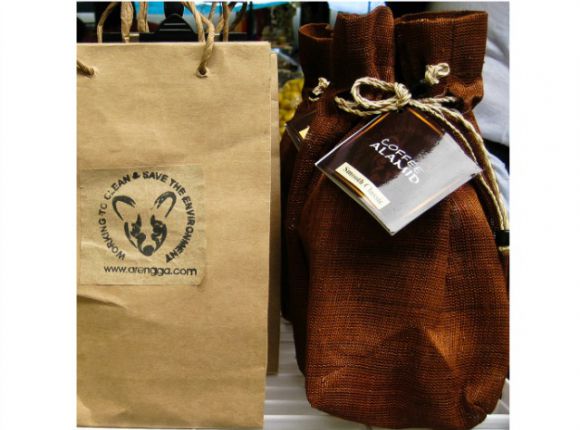
Coffee Alamid is one of the most coveted by coffee connoisseurs the world over, fetching price tags of up to US$1,000 a kilo. With great pride, it is found, picked, roasted and sold in the Philippines. Alamid takes its name from the animal to whom we owe the interesting flavors of these coffee beans – the Palm Civet or locally known as alamid.
So what makes Coffee Alamid so special? It starts off with the alamids picking the ripest and finest berries to eat, by smell. The animals stuff themselves with it and excrete them all in the morning as the beans cannot be digested. It is in their digestive tract that miracles happen. The stomach acids and enzymes affect the chemical structure of the beans. The beans pass through the civet whole after fermenting in the stomach and that’s what gives the coffee its unique taste and aroma.
If you have seen the movie by acclaimed director Rob Reiner, The Bucket List, the first scene of the movie while in a courtroom-case that decided the fare of one his hospitals, Jack whips out a cup of Coffee Alamid before answering one of the judge’s questions. It is, he boastfully said, “This is the most expensive coffee in coffee world. But I do not know why”. Now, you do.
You can purchase authentic Coffee Alamid at farm price at the Sunday Sidcor Market at Centris Walk on Edsa Avenue. Look for Mr. Willie or Ms. Dholly of Chavs Marketing. The Sunday Sidcor Market is only open during Sundays from 6AM to 2PM. The price of Coffee Alamid starts from Php P1,400.00 for 50 grms and P2,400.00 for 100 grms.
So what makes Coffee Alamid so special? It starts off with the alamids picking the ripest and finest berries to eat, by smell. The animals stuff themselves with it and excrete them all in the morning as the beans cannot be digested. It is in their digestive tract that miracles happen. The stomach acids and enzymes affect the chemical structure of the beans. The beans pass through the civet whole after fermenting in the stomach and that’s what gives the coffee its unique taste and aroma.
If you have seen the movie by acclaimed director Rob Reiner, The Bucket List, the first scene of the movie while in a courtroom-case that decided the fare of one his hospitals, Jack whips out a cup of Coffee Alamid before answering one of the judge’s questions. It is, he boastfully said, “This is the most expensive coffee in coffee world. But I do not know why”. Now, you do.
You can purchase authentic Coffee Alamid at farm price at the Sunday Sidcor Market at Centris Walk on Edsa Avenue. Look for Mr. Willie or Ms. Dholly of Chavs Marketing. The Sunday Sidcor Market is only open during Sundays from 6AM to 2PM. The price of Coffee Alamid starts from Php P1,400.00 for 50 grms and P2,400.00 for 100 grms.
Where to find it:
Sunday Sidcor MarketAddress: Centris Walk on Edsa Avenue
Operation Hours: Sunday: 6AM–2PM
19. Dried Mangos (Already Sealed in Vacuum Packs)
.jpg)
Some travelers say that one of the best mangoes they have tasted is found in the Philippines. Philippines has the sweetest mangoes which are, without a doubt, the best tasting mangoes in the world! Unfortunately, it is difficult to carry a kilo of mangos in your luggage. The solution - dry them up while keeping the sweet goodness and seal them in vacuum packs so as to retains their awesome flavor. No preservatives guaranteed. These dried mangoes have a sweet, non-acidic flavor, lush, sweet, tasty, rich in vitamins, and a healthy alternative to sugary snack. And it is 100% fat free! Dried mangoes can be eaten as is, as snack and dessert or used as ingredients for ice cream mixes and toppings. It originated in Cebu which is well-known for its delicious, tasty dried mango - one of the favorite present fruit snacks of Filipinos here and abroad.
Besides the usual dried mangoes, other mango products are dried mango strips, dried mango chips, mango cubes in light and heavy syrup, mango slices in syrup and mango nectar. The price range of the Dried Mangos is from around Php 64.75 (100g) to Php 125.75 (250g). It is available for purchase at Kultura Filipino at the 2nd floor SM Ayala, Makati City. The shop is open from 10AM to 9PM daily.
Besides the usual dried mangoes, other mango products are dried mango strips, dried mango chips, mango cubes in light and heavy syrup, mango slices in syrup and mango nectar. The price range of the Dried Mangos is from around Php 64.75 (100g) to Php 125.75 (250g). It is available for purchase at Kultura Filipino at the 2nd floor SM Ayala, Makati City. The shop is open from 10AM to 9PM daily.
20. Barrel Man/ Woman

Image Courtesy of: Kguirnela
A barrel man is a type of wood carving guaranteed to make the recipient chuckle. It features a naked man or woman hiding inside the barrel. It is hand carved by one of the oldest living tribes in the Philippines. Normally, it can only purchased by traveling to the villages located in the mountain regions of the north. The statuette usually consists of a crude male figurine carved out of wood, surrounded by a round wooden barrel or storage barrel. After the barrel is taken off, the male figure inside is revealed, including a prominent phallic symbol/phallic protrusion on the lower part of the figure.
This gift is fairly common at gift shops in Manila, and especially in the Mountain Provinces. And it is somewhat popular among tourists who may be surprised the first time they encounter the object and lift the object's barrel. The souvenir's origin is relatively unknown, but it has been referred to as an Igorot, suggesting that it may represent the "primitive" mountain inhabitants of the country's history. The barrel man has also been identified as a part of Philippine culture and art, often as the subject of Filipino-related jokes. In recent years, the barrel woman version has come into being as well. The surprise is the woman's breasts. The price of the Barrel Man/Woman starts from around Php 100 to Php 250.00.
This gift is fairly common at gift shops in Manila, and especially in the Mountain Provinces. And it is somewhat popular among tourists who may be surprised the first time they encounter the object and lift the object's barrel. The souvenir's origin is relatively unknown, but it has been referred to as an Igorot, suggesting that it may represent the "primitive" mountain inhabitants of the country's history. The barrel man has also been identified as a part of Philippine culture and art, often as the subject of Filipino-related jokes. In recent years, the barrel woman version has come into being as well. The surprise is the woman's breasts. The price of the Barrel Man/Woman starts from around Php 100 to Php 250.00.
Where to find it:
Jonats HandicraftsAddress: Stall 32-34 Building 11, Ortigas Ave. cor E. Rodriquez Ave. (C-5), Tiendesitas, Pasig City
Other Interesting Souvenirs from the Philippines
If traveling to the Philippines is not on your immediate agenda, or you simply can't afford an extra space in your luggage, fortunately, these days, you can find a wide selection of authentic and truly interesting Filipino souvenirs online. Presented here are some of the Filipino products sought by foreign visitors, now available online for your convenience.
1. Filipino Exotic Tea - Authentic teas of the Philippines are renowned for their mild taste of exotic wild and pure dried leaves. Filipino tea is more than just a beverage. Some say, it's a super food, loaded with natural nutrients and antioxidants. 100% natural product. Drinking it once, you will want more.
2. Filipino Organic Cosmetics -Filipino-made organic cosmetic products are noted for their unique ingredients, among which are the natural enzyme from papaya, Kojic acid, and hand-poured beeswax produced by honey bees of the genus Apis. They give the skin a youthful appearance, fade dark spots and freckles, and promote skin renewal.
3. Filipino Sweets - Purely natural and healthy chocolate made of roasted peanuts, can sugar, milk powder, cocoa powder, and vanilla. No chemicals added. It tastes exactly as you would imagine - a strong flavor of peanut and chocolate. Purple Yam Jam, another popular snack from the Philippines, and is made of purple yam and cane sugar. A true Yam Yam!!!
Get GPSmyCity App for IOS or Android
You can read offline thousands of travel articles like this one in the "GPSmyCity: Walks in 1K+ Cities" app on Apple App Store or Google Play Store. The apps also offer city offline maps and GPS navigation to guide you to the places featured in the articles.
Walking Tours in Manila, Philippines
Create Your Own Walk in Manila
Creating your own self-guided walk in Manila is easy and fun. Choose the city attractions that you want to see and a walk route map will be created just for you. You can even set your hotel as the start point of the walk.
Historical Buildings Walking Tour
Manila’s long history results from its situation as a natural port in a huge bay. With the Spanish conquest of the Philippines in the 16th century, it became united, along with Mexico City and Madrid, into the first truly globalised trade system. Intramuros, Manila’s old walled Spanish town, stood for 350 years before World War II came, and still houses many of the historic buildings.
For a... view more
Tour Duration: 1 Hour(s)
Travel Distance: 2.5 Km or 1.6 Miles
For a... view more
Tour Duration: 1 Hour(s)
Travel Distance: 2.5 Km or 1.6 Miles
Manila Introduction Walking Tour
The capital of the Philippines, Manila was officially founded in 1571 by Spanish conquistador Miguel López de Legazpi. However, an organized polity, called Maynila (meaning "where indigo is found" in Tagalog), existed on the site since as early as 1258.
The earliest human life in the area dates to 3000 BCE, but much of the existing constructions found around the city were created... view more
Tour Duration: 2 Hour(s)
Travel Distance: 2.3 Km or 1.4 Miles
The earliest human life in the area dates to 3000 BCE, but much of the existing constructions found around the city were created... view more
Tour Duration: 2 Hour(s)
Travel Distance: 2.3 Km or 1.4 Miles
Traditional Markets
Traditional markets showcase a unique aspect of life in any city. The ones featured in this walk offer a glance into the authentic life and habits of Manila’s people and play a vital role in the Philippines' capital's economic and cultural landscape. Traditionally, local markets sell a broader range of products than regular shops can provide: from veggies and fruits to dried fish and... view more
Tour Duration: 1 Hour(s)
Travel Distance: 3.0 Km or 1.9 Miles
Tour Duration: 1 Hour(s)
Travel Distance: 3.0 Km or 1.9 Miles









